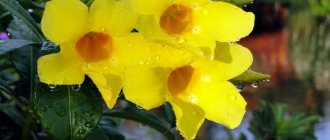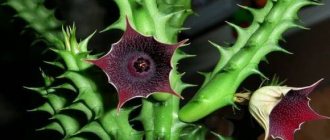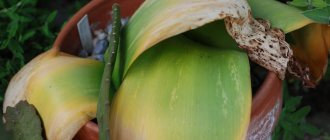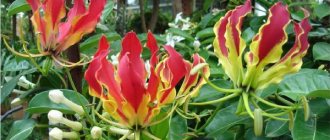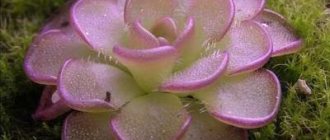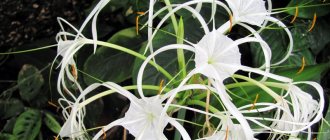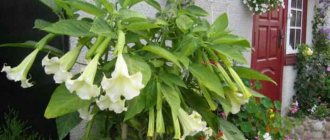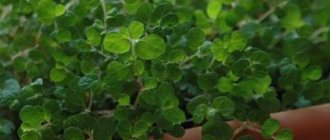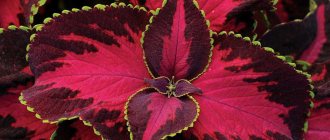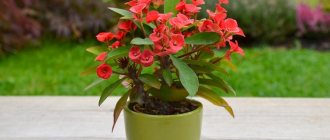What you need to know about Brugmansia
Brugmansia is a heat-loving flower that can be grown both in containers and in open ground. The plant is represented by small trees and shrubs. Some varieties can reach 5 meters in height.
The flower does not like drafts or lack of light. Needs replanting, fertilizing and timely pruning. The first pruning is carried out in the second year of the plant’s life - dry branches are removed and new ones are shortened.
Brugmansia is sown from January to March, and it blooms from July to December.
Supports, pruning and shaping Brugmansias
Due to its size, this amazing plant often cannot do without additional support.
Moreover, it is not the central shoots that require support, but the youngest branches with very heavy flowers. Supports for Brugmansia are usually not installed in advance, placing them only when the plant itself cannot cope with lush flowering. For Brugmansia, which is preserved as a perennial plant and taken indoors for the winter, early pruning is a must. It is advisable to carry it out at the very beginning of spring or at the end of February, no later than mid-March. All shoots on the plant are carefully examined and the V-shaped branches from which the flower stalks and all the branches in the flowering part of the bush develop, including small side shoots developing in the upper part of the crown, are not touched. Such branches seem unproductive and thicken, but they are the main flower stalks and it is they who create such a beautiful Brugmansia crown. It is quite easy to navigate the plant: the leaves in the non-flowering zone are whole, with a symmetrical base, but in the “flowering” tier, which should not be touched, they have ledges at the base of the leaf plate. Only non-flowering shoots are trimmed, slightly shortening the tops (no more than 3 buds). As with any shrub, damaged, overly elongated, dry shoots, as well as unproductive thickening branches in the non-flowering tier of the crown, must be removed from Brugmansia.
If transportation is difficult and requires moving or transporting heavy plants over long distances, then Brugmansia can be pruned not after a dormant period, but after the plant has been standing under a canopy in intermediate conditions, and pruning can be done according to the general rules.
Seed preparation
The germination rate of Brugmansia seeds is 70-80%, so it is important to prepare them for sowing to increase the chances of getting more beautiful plants.
Preparation takes place in 3 stages:
- Disinfection - keep the seeds for half an hour in a solution of Fitosporin (can be replaced with potassium permanganate).
- Soaking - to speed up germination, seed material is dipped in Epin solution.
- Breaking the shell - using any sharp object, cut the seed shell to make it easier for the sprout to release.
Features of reproduction
There are two methods of propagating Brugmensia - generative (seeds) and vegetative (cuttings and air layering). Each species is used to one degree or another by summer residents.
Seed method
Propagation of Brugmansia by seeds is quite rare, and besides, planting a plant and caring for it is more difficult than using other methods of propagation
It is important to remember that no seed seller can ensure the exact germination of the material (the seed may germinate ten days after planting, or may not emerge from the ground at all)
The crop obtained using this method will begin to bloom only next year. Another disadvantage is that the varietal characteristics of hybrid varieties disappear during seed propagation.
Features of sowing:
first, it is important to prepare the seed material (for this, the seeds are placed in a growth stimulator for one day or their shell is scratched with the tip of a small knife); then the seeds are laid out in the soil to a depth of ten millimeters, the soil is moistened and covered with a film on top (at the planting site the temperature is maintained at 20 to 25 degrees Celsius); After the first shoots appear, the film must be removed, spraying the sprout with water continues until the fifth leaf develops on it, after which the crop is transplanted into a separate container.
It is important to remember that Brugmansia is a poisonous crop. All parts of the flower contain atropine, scopolamine and other toxic elements (intoxication can lead to diarrhea, loss of consciousness, and severe hallucinations)
This flower poses a particular danger to children who may accidentally taste the leaves or flowers of the plant. When cutting the crop, it is important to wear gloves so that its juice does not accidentally get on the skin of your hands.
Propagation procedure by cuttings
Considering all the disadvantages of propagation through seeds, many gardeners are wondering how to propagate a plant from cuttings. Cuttings are a fairly popular method of crop propagation, as it leads to a quick and effective effect. Cuttings are allowed to be carried out every year, but the best time is considered to be spring (after the end of the sap flow process) and autumn (before the onset of sub-zero temperatures).
Before growing a plant from a cutting, it is important to first select and prepare material for planting. For this, it is best to use apical shoots of a lignified type with a bud (up to 25 centimeters)
Experts also allow the use of side buds for this procedure, but in this case the flowering of the crop will begin a year and a half later.
After cutting the cuttings, it is important to free them from excess foliage. After this, the cuttings are placed in a container with soft warm water (usually activated carbon is added)
For best seed germination, it is important to keep the planting container warm.
Air layering
Flower growers can propagate Brugmansia not only using seeds and cuttings, but also by air layering. To do this, a transverse cut is made on lignified annual shoots (¼ of the part)
It is important to treat the incision with a root formation stimulator (Kornevin is most often used for this), wrap it with sphagnum, moisten it with water and place it in a separate film
It is important to water sphagnum moss from time to time. After seven weeks, you need to check the sprout for the presence of roots.
If they are present, then the shoot can be cut off, excess leaves removed and rooted in a container with a light and fertile soil mixture.
Soil preparation
It is not necessary to prepare the soil for sowing seeds with your own hands. In the case of Brugmansia, a ready-made commercial substrate for indoor flowers is quite suitable for you. The plant loves loose soil, so add perlite or sand. You can also improve its quality with humus.
The finished mixture is disinfected with Fitosporin solution.
The soil requirements of mature plants are slightly different. The mixture for them (for the purpose of transplanting into a larger pot) is prepared from peat, sand and clay. In open ground, Brugmansia prefers loam.
Ways to grow Brugmansia at home
Usually the plant is fed from seeds. Of course, this procedure is lengthy and requires special knowledge, but still you will be able to extract powerful and good-quality young seedlings
But, you need to take into account the fact that this method does not guarantee the preservation of all species characteristics. The technology for breeding Brugmansia by seed will be divided into a series of stages.
1. First, we organize the basis for planting. The seeds are quite dense, so they need to be moistened for at least 24 hours. It would not hurt to add the root biostimulator for good growth. There is one more trick: you need to disturb the seeds a little - scratch them a little with a knife or a point to spoil the cover.
2. The germs have been touched, now we prepare the soil for their planting. Neutral garden soil is optimal. When planting, make a 1 centimeter deepening.
3. Planted, then we adhere to the conditions for successful growth. The temperature should be about 27°C; all containers must be covered with paper or film. It is also worth remembering about lighting. In about 30 days the first shoots will appear.
https://youtube.com/watch?v=Xl69vaZ2eLA
4. Then we place the completed young plants in their own spaces, each in a separate container. With this planting procedure and normal care, within 2 years our beauty will bring us pleasure from its flowering.
If the seed method is difficult or you are very impatient to inherit an exclusively selected variety, it would be more correct to go to cuttings. The work must be done in the spring (preferably early). We will strengthen only in liquid or perlite. We will definitely organize a greenhouse environment with the support of film or cans. With this method of propagation, after planting the plant and with ideal supervision, in about a couple of weeks you will see newly formed roots.
Planting and caring for Brugmansia: basic gardening tips
In order for the flower to feel comfortable, it is worth choosing a place with some shading and completely safe from gusts of wind. It is necessary to ensure very proper watering. If the summer period is dry and hot, we water it every day with only lukewarm water. Under no circumstances should you moisten from a distance with a hose; it is forbidden to allow liquid to leak onto the opened buds.
When we care for Brugmansia and plant it, we need to remember about fertilizer. Throughout the entire period of growth development and until the very beginning of the autumn period, we add mineral fertilizers approximately once every 7 days. Complex fertilizers such as nitrogen-phosphorus-potassium would also be useful. And of course two words about cutting. In the hot season it is not needed on the site, but in the cold season in the tanks at home you will need to trim off tender and weak shoots.
Sowing Brugmansia seeds
Sowing consists of five simple steps:
- The substrate is lightly watered so that it is moist, but at the same time loose.
- The seeds are carefully distributed over the surface at a distance of 3 cm from each other and pressed down slightly. Next they need to be sprinkled with a small ball of soil (0.5 cm).
- The container with the seeds is sent to a bright and warm (22-25°C) place. Seedlings need ten hours of daylight, so take care of lamps or other sources of additional lighting.
- The container is opened slightly several times a day. Condensation can be observed on the lid at this time. It must be removed with a clean napkin.
- From time to time the soil needs to be watered.
Brugmansia loves moisture, so spray the hatched seedlings with water using a spray bottle. They will appear at different times. You will see the first ones in two weeks, the rest will take several months.
Uses of the Brugmansia plant
In tropical and subtropical regions, Brugmansia is grown in gardens. In countries with temperate climates, it acts mainly as a houseplant and greenhouse plant. Most often this is fragrant Brugmansia (B. suaveolens) or its hybrids.
The popular garden snow-white Brugmansia (B. x candida) was obtained by crossing golden and multi-colored brugmansias (B. versicolor).
The plant has medicinal properties, but the side effects from the use of brugmansia are too serious for its preparations to be used in official medicine. Indians use them to treat rheumatism, arthritis, dermatitis, helminthiasis and flatulence. In Ecuador, Brugmansia seeds are used in chicha, a traditional low-alcohol drink made from corn kernels, drunk on holidays and during religious ceremonies. The leaves are added to smoking mixtures. All parts of the plant contain strong alkaloids (scopolamine, atropine and hyoscyamine), which can cause serious poisoning in humans with stupor and hallucinations. Possible death.
Brugmansia flowers hang freely from the branches, thanks to which rainwater flows down the corolla, like an umbrella, and the pollen inside remains dry.
Brugmansia species, varieties
The family includes 11 varieties that are visually similar to each other. But each variety differs in genetic and morphological characteristics.
Brugmansia tree is the most common species, famous since the mid-18th century. This species is also the most popular among gardeners. There are a large number of varieties, from which numerous varieties have been bred. In the wild world, a particular species is considered completely destroyed and is found only in culture. The standard tree height is 4-5 m, some varieties do not exceed 2 m. Among cultivated trees, the norm is considered to be a bush height of 1.5-2 m. Selected varieties can have terry multi-tiered foliage and flowers of various colors.
Brugmansia snow-white. The dazzling white inflorescences are considered a special feature. Some selection varieties have fringed flowers, painted in light pink, yellow, and light orange tones. The height reaches 2m, the shoots are located close to the ground.
Golden is a bright representative of tall varieties, capable of reaching over 6 m in height. The color of the corollas varies from lemon to orange.
Blood red Brugmansia. This species can hardly be called a shrub because its height can reach 14m. The corollas have a memorable color - the main shade is orange, and the veins are a bright yellow tone. The variety received its name due to the rich red edging that outlines the edge of the flower. This variety is the only representative that has no aroma.
Unlike other fragrant varieties, it is pollinated by small hummingbirds. The blood-red variety is the most frost-resistant species, easily tolerating low temperatures and retaining vitality during short-term frosts.
Multi-colored is the owner of the largest outstanding flowers. The length of the flower reaches 50cm. The variety acquired its name due to the shade of the corolla - at the base the tube has a light green tint, smoothly turning into creamy yellow, and the limb of the petal turns into a rich scarlet or orange tint.
Brugmansia is fragrant - it has, compared to other varieties, small but very fragrant flowers. The corollas are white or yellow, at the stage of budding they are light pink. The height of the bush is 1.5 m, but the variety grows quite quickly, and the stems have the peculiarity of branching. It is the most frost-resistant, unpretentious variety with a subtle, refined aroma.
Interesting! For cultivation in botanical gardens and greenhouses, breeders have developed several hundred different varieties with different colors, shapes and sizes.
Brugmansia, planting and care in open ground, wintering and reproduction
Types and varieties of Brugmansia
There are several different varieties of tree-like Brugmansia that have taken root in indoor conditions.
Golden or yellow brugmansia (aurea) is distinguished by a wide bend of the petals. As the name suggests, the flowers can be any shade of yellow.
Fragrant or aromatic brugmansia (suaveolens) has the strongest aroma compared to its “relatives”. The fragrant petals can be of different shades: pink or yellow with smooth transitions to white or light green. Large tubular flowers have elongated tips; the petals can be either simple or double (see photo).
This variety itself grows extremely quickly and branches very actively, taking on a spectacular appearance.
White or snow-white brugmansia (candida), as seen in the photo, is distinguished by low shoots. Large tubular flowers, similar to bells, consist of 5 lobes. The edges of the corolla have long tips. In addition to white, the petals may acquire a peach or other soft yellow tint.
Specimens with blue flowers are less common, but most often such plants turn out to be not Brugmansia, but Datura (Datura). This is a genus of plants to which Brugmansia was previously classified, before it was separated into a separate genus. You can distinguish fairly similar plants in a simple way: Brugmansia's flowers always hang down, while Datura's flowers most often look up and in different directions.
Brugmansia aromatica (fragrant)
The fragrant brugmansia plant is native to Brazil. The hotter the climate, the better it grows. If you create comfortable indoor conditions, you will enjoy flowering all year round. But keep in mind - the bush grows up to 5 meters in height. It is worth taking care of the appropriate ceiling height. The fragrant Brugmansia flower is white or light green and large in size. Some specimens reach 30 centimeters in length.
Brugmansia aromatic variety
Brugmansia golden
Scientists do not know why golden brugmansia turns yellow. But the fact remains that the color of the flowers looks impressive. In addition, this species is easy to recognize by its long, fairly large leaves. Some of them reach 50 centimeters in length.
Variety Brugmansia golden
Brugmansia snow-white
The second name of this species is woody. In nature it grows up to 3 meters, less in decorative conditions. The flowers are long and snow-white.
Variety Brugmansia snow-white
Brugmansia sanguinea
A distinctive feature of the species are orange-red flowers with yellow veins, which have absolutely no aroma. At prolonged temperatures above +25°, the plant refuses to bloom. Under natural conditions, the species is distributed in Chile and Ecuador.
If you want to buy a Brugmansia flower
If all the warnings are taken into account, and no difficulties frighten you, go to a specialized store for strong and healthy Brugmansia. If you want to shape a plant according to your goals, design tastes and preferences, purchase a young small specimen. A rooted cutting will cost you 300-600 rubles.
If you just want to decorate your interior with “angel trumpets,” buy an adult and large specimen right away. Although, of course, its price will be higher: from 600 to 1000 rubles.
You can buy Brugmansia from your hands much cheaper: for 250 rubles, and in rare cases its price can be only 50 rubles. But in this case, you will probably have to correct all the mistakes of the previous owner.
Carefully inspect the selected plant. There should be no damage or suspicious foreign phenomena on it: spots, wet areas, dry tips on the leaves, etc. There should be no signs of wilting or traces of pests (as well as themselves, of course).
Even if you are sure that you have thoroughly examined the plant in the store, it is recommended to quarantine the newly purchased specimen for several weeks.
Transplanting young Brugmansia
A young plant requires frequent replanting - perhaps even several times throughout the year. In the first years it grows very quickly, and as soon as the roots of the plant entangle the earthen ball, it is time for a new transplant. A grown plant will not require such frequent “relocation” from you: it will be enough to replant it once a year in the spring, and then even less often, as needed.
In very mature plants, they simply replace some of the old soil with new one. In this case, the plant is taken out of the container and the earthen ball is carefully loosened using a regular fork. It is important not to damage the root system. But roots that are too long can be cut off by treating the cuts with crushed coal. Plant the plant in the same pot and cover it with new soil.
After each transplant, the first watering of Brugmansia is carried out with the addition of a root-forming stimulant. This is not necessary, but it will greatly help the plant to take root faster.
Be prepared for the fact that over time Brugmansia will need a tub with a volume of up to 15 liters.
Breathable soil is preferable for angel trumpets. To do this, you need to add some kind of loosening component to the ground: expanded clay, sand and something similar. A drainage layer is also necessary. In this case, the composition of the soil must be fertile: a mixture of loam, compost (one part of each) and peat (two parts) is suitable.
Choosing a pot
In summer, the plant may well bloom in the garden, but in winter it should be moved to home conditions. To do this, you need to choose a pot of the appropriate size for him. Brugmansia arborescens, for example, can be grown exclusively in a pot.
You should choose a larger container so that the massive roots of the flower can fit in it. In addition, it must be heavy so as not to tip over under the weight of the plant. Flowerpots with a capacity of 10–15 liters, tall tubs and plastic pots are suitable for this.
Soil treatment
The soil for seedlings must be fertile. In addition, it must contain peat and sand in equal proportions and be sterilized in a water bath or in the oven. Before planting, the container must be filled with this substrate, placing a drainage layer on the bottom. This will prevent moisture from accumulating at the roots of the plant.
Did you know? This flower was named after the Dutch chemist, botanist and physician Sebald-Justin Brugmans (1763–1819), court physician to King Napoleon III.
Illumination
Loves light very much. If there is little of it in winter, then it is better to put the plant in a cool room until the beginning of spring, where it will be dormant.
Temperature
This is a very heat-loving plant and if the temperature drops below 5 degrees, then more varieties may die. The most suitable temperature in summer is from 22 to 25 degrees.
How to water
In the spring and summer, when Brugmansia is actively growing, it needs to be watered abundantly. When flowering begins and growth stops, watering can be reduced slightly. In winter, you need to water rarely and little by little, but keep an eye on it. so that the soil does not dry out.
Trimming
To prevent damaged and dry branches from spoiling the appearance of the crown and depleting the plant, they must be pruned. For this procedure, the time is usually chosen before mid-March.
Y-shaped shoots should not be pruned, as flower stalks will form on them during the flowering period. In addition, you should not get rid of small and side branches, as flower buds will appear on them. In case of urgent need, they can be shortened by 1/3. It is also necessary to remember that before the seeds form, the fruits should be cut to prolong the flowering period.
Important! When pruning the plant, it is necessary to wear gloves, because all parts of the bush are poisonous and contain alkaloids and scopolamine.
Propagation of Brugmansia by cuttings
Brugmansia reproduces not only by seeds; most often, gardeners prefer propagating Brugmansia by cuttings. To do this, take annual plant shoots 15-25 cm long, with an apical growth point - such cuttings take root better and begin to bloom earlier. Brugmansia cuttings are cut and rooted in late spring or early summer: the lower leaves are removed, placed in water with the addition of activated carbon and placed in a warm (at least 20 ºC) bright place. To prevent the leaves from withering, they are sprayed with warm water and covered with a plastic bottle.
After two weeks, roots will appear, and when they grow to 5 cm, the cuttings are transplanted into pots with a substrate of two parts peat, one part perlite and one part sand. In two to three weeks the cuttings will take root.
Brugmansia after flowering
In the fall, Brugmansia is brought into the house to save it from unexpected frosts. The signal to move to “winter apartments” is a decrease in night temperature to 5-7 ºC. At home, Brugmansia will smell fragrant and bloom until the New Year, or even longer. Sometimes the plant does not have a dormant period at all, and flowering does not stop. But if you want to give the flower a rest until next spring, you will have to create certain conditions for it: move it to a cool, spacious room, stop feeding and reduce watering.
Brugmansia in winter
There are two ways to preserve Brugmansia in winter . You can leave it in a warm room, placing it near the window and maintaining the summer regime of watering, fertilizing and spraying, but at the same time you will have to provide additional lighting for it on dark winter evenings, and then Brugmansia will continue to bloom as it bloomed in the summer in your garden. But not every house can accommodate such a large plant as Brugmansia for the winter, so there is a second option: wintering in a dark, dry basement at a temperature of 5-8 ºC. In this case, watering should be rare, but sufficient so that the soil does not dry out.
The plant will most likely shed its leaves, but at the end of winter new buds will begin to appear on it, and you will move it into the light. The principle of keeping Brugmansia in winter is as follows: the higher the temperature of the room in which Brugmansia is located, the more light the plant will need.
Errors in care and methods for solving them
The most common mistakes in caring for this plant include lack of moisture or lighting. To solve such problems, you just need to increase watering or move the flower to a more suitable place.
Did you know? The rituals of the Indian tribes were full of rituals with elements of using an infusion of Brugmansia flowers, since it had an intoxicating effect. This was regarded as the ability to communicate with spirits and predict the future. If you notice that Brugmansia has slowed down its growth, then do not panic, because its most intensive development is observed during the first year. After this, growth may stop.
If the buds begin to fall off, this may be due to sudden temperature changes and climate change. To solve this problem, you should provide the flower with plenty of lighting and regular watering.
If rotting occurs, this may indicate that the soil in the pot is too heavy and there are no drainage holes. In this case, you will have to replant the plant, first removing the damaged roots.
In general, growing Brugmansia will not cause much trouble with proper care and timely replanting. In addition, maintaining the required temperature and humidity levels in the room will also contribute to the successful growth and development of the shrub.
Is Brugmansia poisonous or not?
All parts of this plant contain alkaloids, among which is scolopatine, a psychotropic substance. Therefore, when working with it, you must wear gloves and a protective mask.
Important! Brugmansia should not be planted near children's playgrounds.
How to feed Brugmansia
10 days after planting, Brugmansia needs to be fertilized with organic matter: mullein 1:10 and chicken manure 1:15. In the future, feeding should be carried out regularly at intervals of 2 weeks. Until mid-summer, you can use complex mineral mixtures with a high nitrogen content, and then with a high concentration of phosphorus and calcium.
Brugmansia pests and diseases
This plant has high natural immunity, but if the growing conditions are inappropriate, it decreases. In this case, Brugmansia becomes susceptible to pests and diseases.
Possible problems:
- Spider mite. This harmful insect is difficult to see with the naked eye. The lesion can be recognized only by the presence of small yellow dots along the edge of the plates and a thin cobweb on the top of young shoots. To fight, you need to use Actellik.
- Aphid. A sucking pest that feeds on plant sap. It forms entire colonies that can be seen on the shoots and on the back of the leaves. For destruction it is recommended to use Inta-Vir.
- Slugs. These pests are nocturnal and feed on young foliage. The provoking factor for their reproduction is high humidity. To repel slugs, it is recommended to sprinkle the soil at the base of the plant with wood ash and tobacco dust.
- Brown rot. The disease develops in cool, humid summers. It is characterized by a gray coating on the leaves that interferes with photosynthesis. Subsequently, the affected areas increase in size and completely extend to the entire plate. This leads to premature leaf fall. For treatment it is necessary to use fungicides.
Why do Brugmansia leaves turn yellow?
This problem is the most common. Yellowing of Brugmansia foliage may be due to a lack of nitrogen during the period of active growth, adaptation to a new location, as well as a lack of moisture. In this case, it is necessary to adjust the conditions for caring for the plant.
Why doesn't Brugmansia bloom?
You should not expect flowering in the first season from Brugmansia grown from seeds or from spring cuttings. Most of these plants bloom in the second year, and some in the third.
Brugmansias of terry varieties develop noticeably more slowly. Their flowering period is the third – fourth season.
Incorrect autumn pruning will also leave the bush without flowering, or it will come by the end of summer. When pruning, it is necessary to preserve all the forks (slingshots) on the trunks, then Brugmansia will throw out buds more than once during the season.
You should not try to shape the bush in the summer, do pinching or pruning. Brugmansia forms a crown on its own, and intervention will lead to the shedding of buds.
Irregular watering and fertilizing, overdrying of the soil, untimely destruction of insects will weaken the plant, which will certainly affect flowering
Planting Brugmansia in open ground
Many gardeners grow Brugmansia as an annual plant. However, this deprives them of the opportunity to fully enjoy the beauty and lush flowering of the plant in the garden. And it’s a pity to lose such beauty, knowing that you can preserve it indoors in winter, and in the summer you can start planting and caring for Brugmansia again by planting it in open ground.
Rooting in the substrate
Since not all Brugmansia varieties take root in water, they resort to rooting cuttings in the substrate. Before planting a Brugmansia cutting in a pot, you need to prepare a planting pot. Place drainage (vermiculite, polystyrene foam) at the bottom of the pot, then add substrate. A depression is made in the substrate and a cutting is placed. The earth around the cutting is lightly crushed, then covered with a jar, creating greenhouse conditions. When planting in a substrate, root growth stimulants are used. Up to four pieces are inserted into pots. In a month, the plant will be ready to be transplanted to its permanent habitat.
Rooting Brugmansia cuttings in water
To root cuttings in water, use settled warm water. To prevent stems placed in water from rotting, an activated carbon tablet is diluted in it. A little water (3-5 cm) is poured into the bottom of a jar or plastic glass and the cuttings prepared in advance are placed in a container, then transferred to a warm, well-lit place. Not only water, but also oxygen is involved in the formation of roots, so the water level should not be high. The container with the cutting is covered with polyethylene and placed in a warm, bright place. After 10-15 days, the first roots will appear.
Important! Activated carbon must be added to the water to avoid rotting of the roots.
How to care for it in summer and winter
For winter, the flower is removed quite early. As soon as the night temperature begins to drop below 10 ° C, the plant is transferred first to the veranda for adaptation, and then to the house or room where it will spend the winter. There should not be a sharp transition; it is better to increase the period of stay in intermediate conditions. If a stupefying tree grows in a garden plot, it must be carefully dug up without damaging the root system and, together with a lump of earth, placed in a barrel or pot for wintering. It is transferred to a permanent place when the night temperature begins to drop to 5 °C.
Important! You can save a flower, even if the frost happened suddenly and the bush froze. Then you should immediately remove all damaged parts.
The flower prefers to overwinter at a temperature not exceeding 15 °C. Indoor conditions are not recommended. Moreover, the warmer the room, the brighter it should be. Watering is noticeably reduced; you should wait until the top layer of soil dries out. Feeding is carried out once a month before the start of the active growing season. The flower is returned to open ground after the threat of frost has passed. Most often in early June. Before this, when buds begin to form on the plant, it can be taken out to a well-lit room, for example, to a veranda.
Brugmansia in a pot can be stored at home in winter
Period of activity and rest
The period of activity can continue throughout the summer months. The first flowers appear in early June, the last ones fade in September. But you can extend the flowering period and make the tree bloom even in winter by increasing the length of daylight hours and creating the necessary temperature regime. True, it is better to give Brugmansia a rest. The dormant period lasts from mid-autumn to early spring. At this time, it is better not to disturb her, providing the minimum necessary care. Some people cut the plant and put it in the basement. Due to the fact that the flower is able to rest, it will bloom even more magnificently in the new season.
How to prune Brugmansia?
The rapidly growing Brugmansia needs to be constantly shaped. In spring, all its shoots are shortened by about a third. It is very important to observe moderation. Too much pruning will significantly reduce the abundance of flowering. Since flower buds are already laid on the branches. During the summer, some of the shoots are periodically removed from the bushes. A large number of shoots reduces the number of flowers.
What mistakes do flower growers usually encounter?
It cannot be said that Brugmansia is the princess and the pea, but there are a number of problems that Ukrainian flower growers who grow “angel trumpets” at home do encounter from time to time. We will list these problems so that you can avoid making the same mistakes.
Leaf fall:
- reason: lack of water;
- way to help: regular watering, which corresponds to the temperature and humidity level in the house.
Thinning of stems:
- reason: lack of sunlight;
- way to help: change the location of the pot, use artificial lighting in winter.
Slow growth:
- reason: lack of nutrients (or the plant has simply reached its maximum);
- way to help: regular application of mineral fertilizers to the substrate.
Bud fall:
- reason: lack of water, “moving” of a flower from one house to another with a different temperature regime;
- way to help: stabilizing the watering schedule, creating favorable temperature conditions for the flower.
Conclusion
Brugmansia cuttings are the most effective means of propagating this plant. Depending on the time of harvesting (spring or autumn), various methods of their preliminary rooting are used. From cuttings obtained in the fall, an adult plant forms faster, although the survival rate of seedlings is somewhat lower. After the plant’s root system has formed, its cultivation is the same for both cutting methods.
Sources
- https://cvetolubam.ru/brugmansiya/
- https://lanshaft.com/wiki/brugmansiya-posadka-i-uhod.html
- https://komnatnie-rastenija.ru/brugmansija-vyrashhivanie-i-uhod-v-domashnih-uslovijah-foto-vidov/
- https://fermer.blog/bok/komnatnye-rasteniya/dekorativno-listvennye/kustovye/1546-opisanie-rastenija-brugmansija.html
- https://rastenievod.com/brugmansiya.html
- https://floristics.info/ru/stati/2155-brugmansiya-vyrashchivanie-ukhod-i-razmnozhenie.html
- https://AgroGnom.ru/kustarniki/brugmansiya-posadka-i-uhod-v-domashnih-usloviyah-podkormka-razmnozhenie.html
- https://dachnyuchastok.ru/brugmansiya-posadka-uhod/
- https://greensotka.ru/tsvetushchie/brugmansiya.html
- https://agronomu.com/bok/1950-kak-razmnozhit-brugmansiyu-cherenkami-rekomendacii-cvetovodov.html
- https://ogorodniki.com/article/vyrashchivanie-brugmansii-v-domashnikh-usloviiakh-chto-gde-kogda
- https://fermilon.ru/sad-i-ogorod/dekorativnye-kustarniki/brugmansiya-razmnozhenie-cherenkami-osenyu-i-vesnoy.html
[collapse]
How to trim
Brugmansia requires mandatory pruning, which must be done every spring. Attention: pruning must be done before the plant wakes up from hibernation.
You should not shorten the branches of the plant too much - this will negatively affect its flowering. And it is worthwhile to put the trimmed material to good use - it can be used for further propagation of Brugmansia. But at the same time, it is necessary to sort out diseased, defective, weak branches, leaving only strong and suitable for further rooting.
When pruning, it is also recommended to completely remove branches affected by any disease, as well as simply weak and frail specimens. Eliminating these “weak links” will help the remaining parts of the plant become stronger and receive more nutrients. But how to prune Budleya in the spring, and how to do it correctly, is described in great detail in this article.
Strong and strong branches are cut to a third of their length. In this case, it is necessary to leave Y-shaped “slingshots” - branches - at the ends of the cut branches. This technique will help the plant grow thicker. If you neglect this advice, Brugmansia will direct its energies to growth, while ignoring flowering.
The plant is pruned for the first time the next year after it begins to flower. But only if the Y-shaped branches necessary for the procedure have already formed on it. Keep in mind that you shouldn’t trim the side branches too much: they will produce more flowers.
